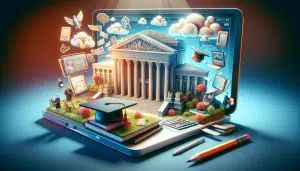Surprising Ways Online Learning Shapes Your Future
Lily Carter October 22, 2025
Online education is changing possibilities for millions, offering access and flexibility once thought impossible. This guide explores how digital classrooms, micro-credentials, and free courses impact career growth, personal development, and lifelong learning. Discover insights into affordability, flexibility, and unique resources shaping the online education landscape.
The Rise of Digital Classrooms and Their Expanding Reach
Digital classrooms have redefined what it means to participate in education. Once confined by geography, time, and resources, educational opportunities now reach learners at all stages and backgrounds. The integration of robust learning management systems, virtual lectures, and peer collaboration tools allows students to take courses from nearly anywhere. Not only does this enable high school graduates to pursue degrees without relocating, but working adults and parents can now balance study with their commitments. Today, digital education platforms are expanding to offer not just undergraduate learning, but also ongoing training, specialized skills, and even advanced certifications. Massive open online courses (MOOCs) bring expert-led classes to a global audience, with participation from top institutions. This democratization of learning opens new doors for students across diverse regions.
Institutions worldwide are actively developing comprehensive online academic offerings. Universities, in partnership with corporate platforms and nonprofits, provide interactive experiences that rival in-person settings. This expansion bridges gaps for those unable to attend traditional campuses due to financial, health, or travel constraints. For many, access to self-paced study means that personal commitments do not need to stand in the way of education. Features such as recorded lectures, discussion forums, and adaptive learning materials allow for personalized guidance and feedback. Data shows that digital classrooms can deliver equal or superior outcomes, especially when learners are self-motivated and supported by effective instruction. Flexibility in coursework scheduling and pace also encourages participation by many who might otherwise drop out or never enroll in the first place https://www.ncbi.nlm.nih.gov/pmc/articles/PMC8024322/.
The shift to online learning is not only about convenience. It is also about the diversity and inclusiveness it fosters. Students with disabilities, those in rural areas, or learners facing other barriers now benefit from tailored materials and assistive technologies built into digital environments. The online classroom often creates space for a broader set of voices and perspectives, leading to richer peer discussions. Innovative use of group projects, virtual breakout rooms, and collaborative assignments provides valuable experience with the digital tools now essential in modern workplaces. As more people experience these benefits, institutions and employers increasingly recognize digital credentials as equivalent to traditional ones for many fields.
Affordability and Flexible Structure of Online Education
Affordability has always been a primary factor influencing access to higher education. Tuition, living expenses, and commuting costs prevent many from pursuing post-secondary qualifications. Online education helps address this through reduced overhead and innovative pricing structures. Many platforms partner with universities to deliver accredited programs, often at a fraction of the cost of traditional degrees. Some even offer scholarships or tuition-free modules on introductory topics. Exploring these options allows learners to start with low-risk investments while evaluating the teaching quality and support systems.
Flexible scheduling is one of online education’s greatest draws. Learners can study at their own pace, fitting coursework around employment or caregiving duties. This flexibility also allows career switchers or upskilling professionals to acquire relevant knowledge without leaving the workforce. Asynchronous lectures, open enrollment periods, and stackable micro-courses empower students to build education into their lives. For those with unpredictable schedules or family obligations, this makes sustained study much more manageable. Moreover, success in self-paced environments often translates into improved time-management and project-planning abilities, skills that are highly valued in the job market https://www.ed.gov/news/press-releases/.
While affordability and flexibility are strong motivators, online students must also consider potential challenges. Time management requires discipline without the structure of fixed class times. Some may feel isolated if support networks are lacking, emphasizing the need to find platforms with active mentorship or community engagement features. Still, the financial accessibility of online learning often outweighs these concerns. Programs designed around life’s realities empower more people to pursue education as a lifelong endeavor, not just a one-time milestone.
Career Growth and the Promise of Micro-Credentials
Micro-credentials are rapidly emerging as a cornerstone of professional development in the digital age. These focused, skill-based certifications allow learners to demonstrate mastery in particular areas—like project management, data analytics, or language proficiency—without committing to multi-year programs. Employers increasingly look for such credentials, which signal both initiative and current, relevant knowledge. Online platforms often partner with industry leaders to create these learning tracks, integrating real-world projects and peer-reviewed assessments.
Short, modular courses lower the intimidation barrier and enable immediate application to professional challenges. For example, someone seeking to transition to data science can complete a series of certificates in statistics, Python programming, and machine learning—all remotely—before diving deeper into the field. In addition to technical skills, micro-credentials frequently provide soft skill development and cross-cultural communication practice. These credentials are often portable between platforms, and many can be listed on public profiles or digital portfolios, boosting visibility with potential employers https://www.brookings.edu/articles/can-microcredentials-boost-social-and-economic-mobility/.
As lifelong learning becomes more important in today’s rapidly changing economy, short credentials empower people to update their skill sets efficiently. Rather than returning to traditional university programs, many professionals take advantage of these targeted options to stay competitive. With new fields emerging, micro-credentials are expected to play an even larger role in workforce development and advancement. This evolution is changing how success and expertise are measured, making education more accessible and tailored to individual career paths.
Inclusive Learning: Accessibility and Personalization Online
Online education breaks many longstanding barriers by offering greater accessibility and personalization for students of different backgrounds and abilities. Courses often feature closed captioning, transcripts, language localization, and screen reader compatibility. Adaptive learning technology adjusts difficulty and activities to suit unique learning styles, benefiting both advanced and struggling students. For learners with disabilities, these design considerations are essential for equitable participation in educational opportunities.
Personalization is a key trend in digital learning. Analytics-driven platforms monitor progress and suggest next steps, offering enrichment or review activities dynamically. Instructors and tutors can intervene when students fall behind, using real-time dashboards. The ability to go over material multiple times, pause and rewind lectures, or choose supplemental resources helps all learners gain a deeper understanding of complex topics. These features make high-quality education available to a broader population, reducing longstanding achievement gaps https://files.eric.ed.gov/fulltext/EJ1207901.pdf.
Communities built around online courses can be truly global. Forums, group chats, and live seminars connect learners from diverse geographical, social, and professional backgrounds. Exposure to multiple perspectives fosters empathy and collaboration—two skills now recognized as essential for success in the workplace and society at large. As platforms continually improve accessibility and user experience, online environments evolve into spaces where equity and inclusion are not just goals, but the standard for learning.
The Role of Free and Public Resources in Lifelong Learning
Free and open educational resources are vital pillars supporting the online learning ecosystem. From basic literacy and numeracy to advanced computer science, learners today can access a wealth of materials without payment. Government initiatives, nonprofit organizations, and world-class universities often provide entire courses, textbooks, or video series at no cost, lowering barriers even further. These resources enable learners to sample new subjects, revisit foundational content, or supplement formal courses.
Major platforms like edX, Coursera, and OpenLearn partner with leading institutions to offer courses in everything from ancient history to cloud programming. Some even feature structured learning paths or recognized micro-credentials alongside free content. Public libraries and educational nonprofits have adopted similar models, providing free local workshops, technology lending kits, or virtual tutoring. With such a range of resources, education becomes an ongoing journey rather than a fixed destination https://ec.europa.eu/education/education-in-the-eu/digital-education-action-plan_en.
While these free resources cannot always replace formal degree programs for specific professions, they allow anyone to build competencies and confidence in new fields. Lifelong learning is more possible than ever. Many individuals use these materials to supplement work-based training, prepare for job transitions, or simply pursue new passions. As the landscape continues to evolve, the widespread availability of free and public materials ensures that the opportunity to learn—and to grow—is within everyone’s reach.
Assessing Quality, Outcomes, and Future Trends in Online Learning
Choosing the right online course or credential can feel overwhelming with so many options available. Reliable accreditation, transparent outcomes, and independent reviews play a crucial role in helping students make informed choices. Many high-quality platforms disclose employment rates, alumni testimonials, and third-party endorsements. Prospective learners can often sample content or preview course modules before enrolling, further improving confidence in their selection process.
Several indicators signal quality in online programs: expert instructors, active community engagement, project-based assessments, and rigorous grading standards. Employers place growing value on digital badges and certifications, viewing them as proof of adaptability and commitment to learning. Research finds that online graduates often report similar or higher satisfaction and professional advancement compared to their peers in traditional settings. Some challenges remain—such as maintaining motivation or navigating technical issues—but the overall trajectory points toward wider acceptance and recognition in society https://educationdata.org/online-education-statistics.
Looking ahead, expect continued innovation in blended learning, virtual reality classrooms, and skills-aligned pathways. Trends suggest growing partnerships between industry and providers to assure courses meet real-world demands. Learners of all ages and backgrounds will benefit as the ecosystem matures and diversifies. For those eager to enhance their knowledge or career potential, staying informed about online learning trends and best practices ensures the greatest returns.
References
1. Means, B., Bakia, M., & Murphy, R. (2014). Learning Online: What Research Tells Us about Whether, When and How. Retrieved from https://www.ncbi.nlm.nih.gov/pmc/articles/PMC8024322/
2. U.S. Department of Education. (n.d.). Press Releases. Retrieved from https://www.ed.gov/news/press-releases/
3. Kato, S., Galán-Muros, V., & Weko, T. (2020). The emergence of micro-credentials. Retrieved from https://www.brookings.edu/articles/can-microcredentials-boost-social-and-economic-mobility/
4. Fredricks, J. A., & Eccles, J. S. (2019). Online Learning and Its Users. Retrieved from https://files.eric.ed.gov/fulltext/EJ1207901.pdf
5. European Commission. (n.d.). Digital Education Action Plan. Retrieved from https://ec.europa.eu/education/education-in-the-eu/digital-education-action-plan_en
6. Education Data Initiative. (n.d.). Online Education Statistics. Retrieved from https://educationdata.org/online-education-statistics







